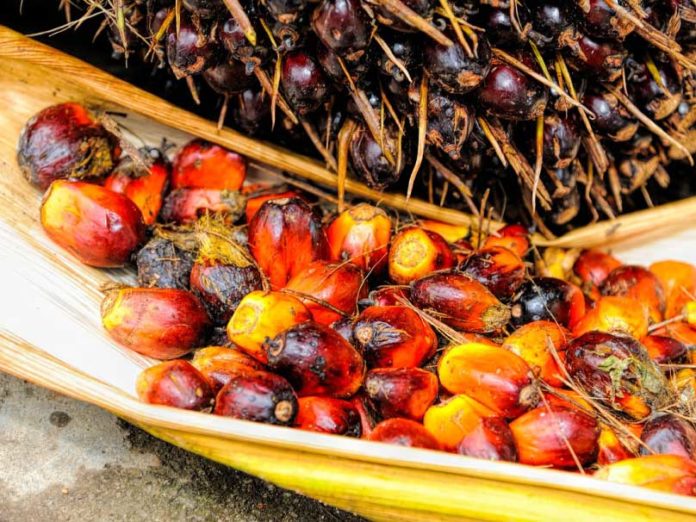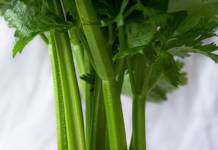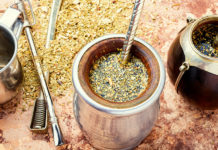Anyone interested in nutrition has likely heard of some of the controversies swirling around palm oil. Claims that it’s good for you, rumors that it’s been banned in Europe, headlines stating that it’s destroying the rainforests, articles warning that it’s worse for your heart health than butter, and more.
These types of claims dot the internet and conversation among those who follow health food news. So let’s sort out the palm oil facts from fiction.
What is Palm Oil?
Palm oil is a vegetable oil made from the fruit of the African oil palm tree. It’s often confused with palm kernel oil. Palm kernel oil comes from the same tree but from the seed, not the fruit. The two oils contain different fat levels, flavor, and vitamin content. Palm oil is 37% monounsaturated fat, 50% saturated fat and 9% polyunsaturated fat. It has 120 calories and 13 grams of fat per tablespoon and is rich in Vitamin E.
In the 60s and 70s, U.S. food manufacturers used palm oil primarily in snacks like cookies and crackers for long shelf life. At room temperature, it’s semi-solid. In the 80s, partially hydrogenated oils, aka trans fats, largely replaced it. Since we’ve learned how bad for us trans fats can be, palm oil has made a comeback. It’s now the go-to fat for foods that require a long shelf life. It also turns up in baked goods, candy, frozen food, and a huge array of products such as toothpaste, cosmetics, and detergents.
Palm Oil Processing
Palm oil starts out a deep reddish-orange color, typical of foods rich in beta-carotene, which palm oil is naturally. Unprocessed palm oil is a good antioxidant. However, as with many foods, processing lessens the health benefits. In this case, it may even cause harm.
When machines are used to extract palm oil or palm kernel oil, they may heat to temperatures that destroy any healthful properties. Some machinery even contaminates the oil with solvents. Look for virgin palm oil, which is extracted at low temperatures and without any solvents.
Snack foods contained more processed versions of palm oil. They often require a solid form of the fat, and palm oil becomes more solid at higher processing temperatures. Look for the terms “fractionated palm oil,” “palm shortening,” or “palm stearin” to signal the presence of this highly processed version.
Keep an eye out for labels that indicate the palm oil in the products you buy was processed properly. And if you buy palm oil for cooking, always choose cold-pressed.
Is Palm Oil Bad for Us?
Palm oil has been used extensively in Asia for many years and gradually increased in popularity in Europe and the U.S. over the past couple of decades. Increasing demand worldwide has caused a palm oil boom. Many economies in Asian countries depend on the production of this staple oil.
What about the rumor that palm oil was banned in Europe? This springs from a study that found certain contaminants in some batches of palm oil. These contaminants are “a potential health concern” according to the European Food Safety Authority. Research showed they have carcinogenic (cancer-causing) and genotoxic (DNA harming) properties when heated to high temperatures. These toxins are present in all processed and refined oils. However, their levels spike to dangerous highs in palm oil if it isn’t processed taking certain precautions. When palm oil is processed properly, using lower temperatures, the level of these contaminants drops to the same levels as other processed vegetable oils.
CNN reported that the maker of the popular hazelnut spread, Nutella, responded to the EFSA’s report. They stated they were able to “significantly reduce the levels of contaminants in its palm oil compared to conventional palm oils available on the market, similar to the levels found in other vegetable oils that have been processed properly, in line with EFSA’s parameters.”
Due to its high saturated fat content, the American Heart Association recommends limiting this oil. However, with 2.17 milligrams of Vitamin E in every tablespoon, palm oil can be a useful addition to your diet. Just keep an eye on your overall saturated fat intake. Also, remember the guidelines above for seeking less processed sources.
Is Palm Oil Bad for the Environment?
Unfortunately, if palm oil is not produced using sustainable methods, the answer is yes. According to Scientific American, the surge in worldwide palm oil demand led to a situation where “farmers across Southeast Asia have been clearing huge swaths of biodiversity-rich tropical rainforest to make room for massive palm plantations.” Production of palm oil has led to deforestation that threatens the world’s shrinking rainforests. It also threatens the existence of many species, like the orangutan, whose populations have been cut in half as a result.
In response, concerned scientists, environmental groups, and governments have begun to take action. The Roundtable on Sustainable Palm Oil (RSPO), a group of palm oil companies, sets standards for producing sustainable palm oil. Also, the governments of Indonesia and Malaysia have taken steps to try and halt deforestation in their countries due to the production of palm oil.
There is still much work to be done to ensure that the world’s hunger for palm oil does not irreparably damage the environment, but it’s an encouraging start. In the meanwhile, try to look for the RSPO label, showing that the palm oil you consume was produced sustainably.
—
PHOTOS: Pixabay / CC0 Public Domain








